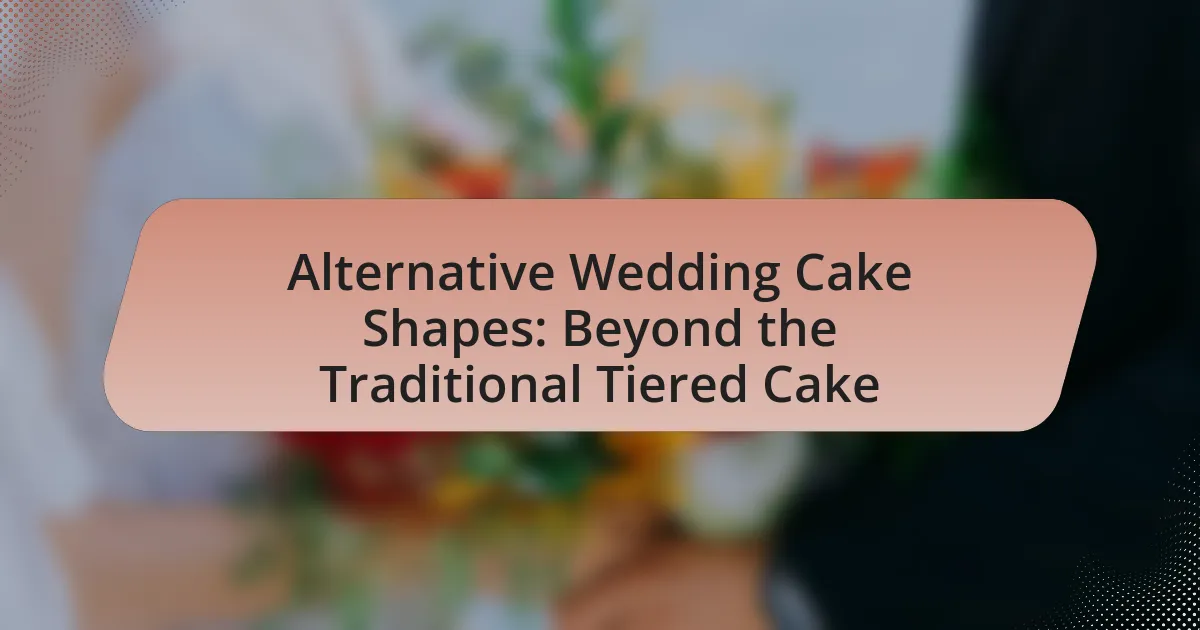Alternative wedding cake shapes are increasingly popular as couples seek to personalize their celebrations beyond traditional tiered designs. This article explores various unique shapes, including geometric, hexagonal, square, and sculpted forms, highlighting how these options allow for greater creativity and individual expression. It discusses the differences between alternative shapes and traditional cakes, the factors influencing shape selection, and the benefits of choosing non-traditional designs. Additionally, the article addresses practical considerations such as serving sizes, transportation challenges, and the importance of aligning cake designs with wedding themes and guest preferences.
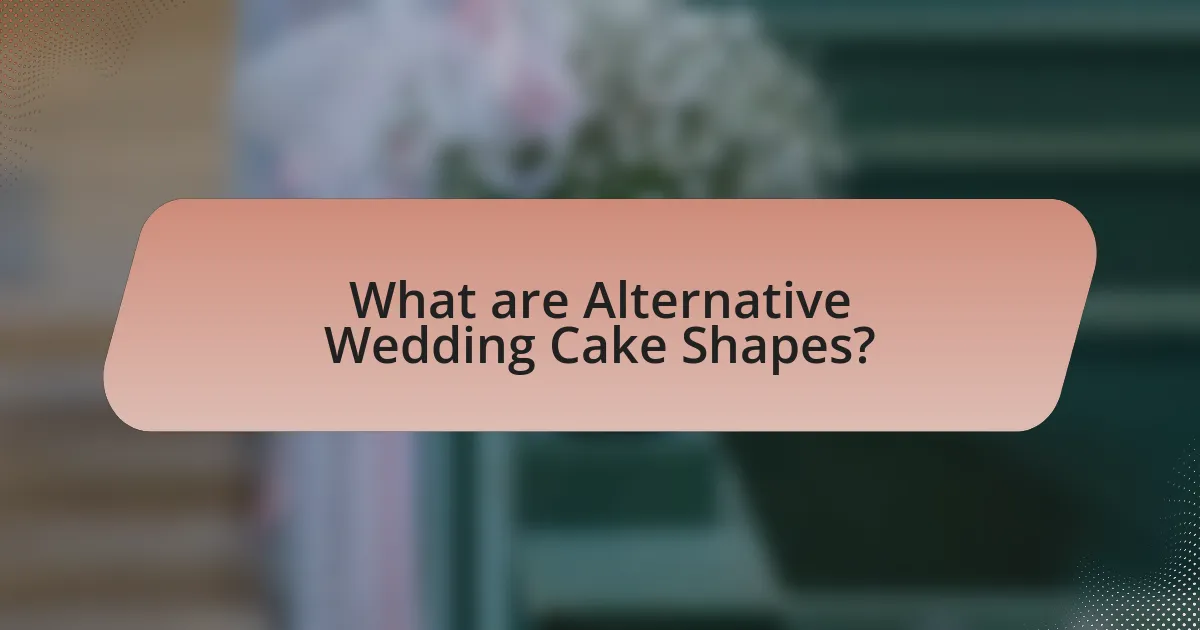
What are Alternative Wedding Cake Shapes?
Alternative wedding cake shapes include geometric designs, hexagons, squares, and even sculptural forms like hearts or stars. These shapes provide couples with unique options that deviate from the traditional round or tiered cakes, allowing for personalized expression in their wedding celebrations. The trend towards alternative shapes has gained popularity as couples seek to reflect their individual styles and themes, with many bakers now specializing in custom designs that cater to these preferences.
How do alternative wedding cake shapes differ from traditional tiered cakes?
Alternative wedding cake shapes differ from traditional tiered cakes primarily in their design and structure. While traditional tiered cakes consist of multiple stacked layers, alternative shapes can include options like single-layer cakes, geometric designs, or even sculptural forms. These alternative shapes allow for greater creativity and personalization, catering to unique themes or preferences, whereas tiered cakes typically follow a more conventional aesthetic. The trend towards alternative shapes has been supported by a growing demand for customization in wedding planning, reflecting individual tastes and styles.
What are the most popular alternative shapes for wedding cakes?
The most popular alternative shapes for wedding cakes include hexagonal, square, and circular designs, as well as more unique forms like heart-shaped and sculpted cakes. Hexagonal cakes offer a modern twist, while square cakes provide a contemporary aesthetic. Circular cakes remain classic but can be customized with various tiers and decorations. Heart-shaped cakes symbolize love, making them a popular choice for romantic themes. Sculpted cakes can take on any shape, reflecting the couple’s interests or wedding theme, showcasing creativity and personalization. These shapes have gained popularity due to their ability to break away from traditional tiered designs, allowing couples to express their individuality on their special day.
Why are couples choosing alternative shapes over traditional ones?
Couples are choosing alternative shapes over traditional ones for wedding cakes to express their individuality and creativity. This trend reflects a desire for personalization in wedding celebrations, as unique cake shapes can better represent the couple’s story or interests. According to a survey by The Knot, 40% of couples opt for non-traditional cake designs, indicating a significant shift towards customization in wedding planning.
What factors influence the choice of alternative wedding cake shapes?
The choice of alternative wedding cake shapes is influenced by personal preferences, wedding themes, and current trends. Personal preferences dictate the aesthetic and flavor choices, while wedding themes, such as rustic or modern, guide the shape selection to ensure cohesion with the overall decor. Current trends, including unique shapes like geometric or asymmetrical designs, reflect contemporary tastes and can enhance the visual impact of the wedding. Additionally, practical considerations such as serving size and ease of transportation also play a role in determining the final shape of the cake.
How do personal preferences affect cake shape selection?
Personal preferences significantly influence cake shape selection, as individuals often choose shapes that reflect their personal style, cultural significance, or thematic elements of the event. For instance, a couple may opt for a geometric cake shape to align with a modern wedding theme, while others might prefer a classic round shape for its traditional appeal. Research indicates that visual aesthetics play a crucial role in food choices, with studies showing that people are more likely to select items that they find visually appealing (Spence, C., & Piqueras-Fiszman, B., 2014, “The Perfect Meal: The Multisensory Science of Food and Dining”). This suggests that personal taste in design directly impacts the decision-making process for cake shapes, leading to a diverse range of selections that cater to individual preferences and event themes.
What role does wedding theme play in choosing cake shapes?
Wedding themes significantly influence the selection of cake shapes, as they help create a cohesive aesthetic for the event. For instance, a rustic wedding theme may lead to the choice of a cake shaped like a tree stump, while a modern, minimalist theme might favor geometric shapes. This alignment between cake design and wedding theme enhances the overall visual harmony of the celebration, making the cake a focal point that reflects the couple’s style and the event’s atmosphere.
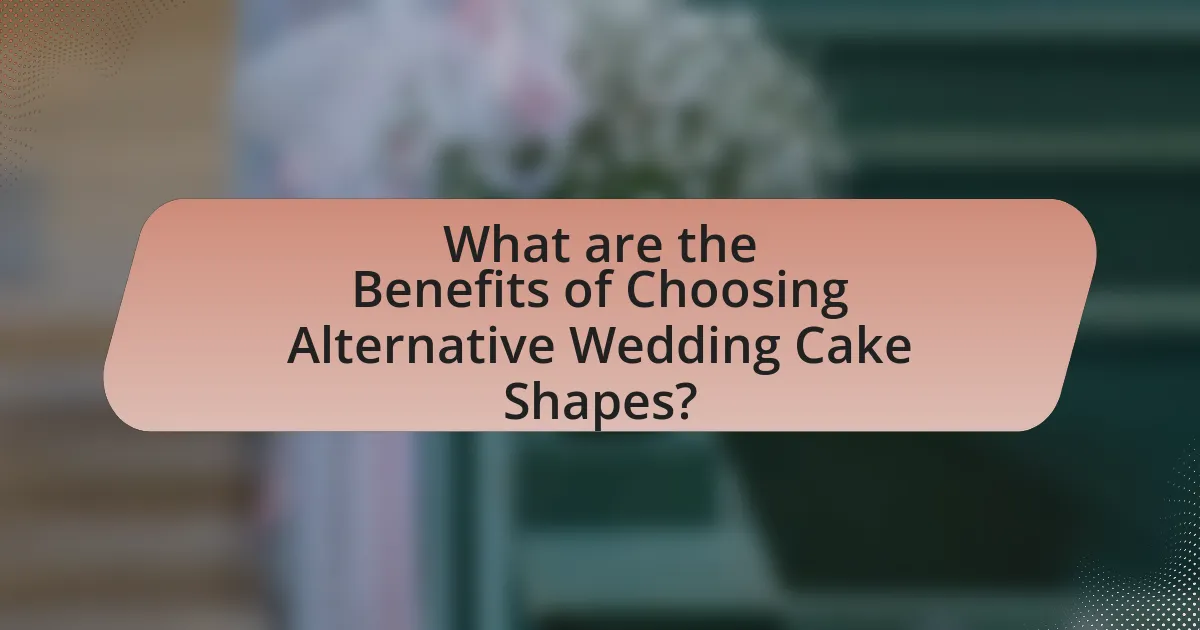
What are the Benefits of Choosing Alternative Wedding Cake Shapes?
Choosing alternative wedding cake shapes offers several benefits, including enhanced personalization, visual impact, and creative expression. Personalization allows couples to reflect their unique style and theme, making the cake a focal point that resonates with their story. For instance, non-traditional shapes like hexagons or hearts can symbolize love and connection, while also standing out in photographs. Additionally, alternative shapes can create a striking visual display, drawing attention and sparking conversation among guests. This creativity can also extend to flavors and fillings, as couples may choose to incorporate elements that align with their preferences, further enhancing the overall experience.
How can alternative shapes enhance the wedding experience?
Alternative shapes can enhance the wedding experience by providing unique visual appeal and personalization that reflects the couple’s style. Non-traditional cake shapes, such as geometric designs or sculptural forms, create a striking centerpiece that captivates guests and sparks conversation. Research indicates that visually distinctive elements at weddings contribute to memorable experiences, as they engage guests’ senses and create lasting impressions. For instance, a study published in the Journal of Consumer Research highlights that unique visual stimuli can enhance emotional responses, making the event more enjoyable. Thus, incorporating alternative shapes into wedding cakes not only elevates the aesthetic but also enriches the overall celebration.
What unique visual impacts do alternative shapes provide?
Alternative shapes provide distinctive visual impacts by breaking away from traditional tiered designs, creating a more dynamic and personalized aesthetic. These shapes, such as geometric, asymmetrical, or sculptural forms, draw attention and evoke curiosity, enhancing the overall visual experience of the wedding cake. For instance, a hexagonal cake can introduce a modern flair, while a freeform design can reflect the couple’s unique story or theme. This variety not only adds visual interest but also allows for greater creativity in decoration and presentation, making the cake a focal point of the celebration.
How do alternative shapes contribute to personalization of the wedding?
Alternative shapes enhance the personalization of weddings by allowing couples to express their unique styles and preferences through cake design. Non-traditional shapes, such as hexagons, squares, or even sculptural forms, can reflect the couple’s personalities, interests, or themes, making the cake a focal point that resonates with their love story. For instance, a couple who enjoys travel might choose a globe-shaped cake, while those with a passion for nature might opt for a floral or leaf design. This customization not only differentiates their wedding from others but also creates a memorable experience for guests, reinforcing the couple’s identity and shared values on their special day.
What are the practical considerations for alternative wedding cake shapes?
Practical considerations for alternative wedding cake shapes include structural integrity, serving size, and transportation. Structural integrity is crucial as unconventional shapes may require additional support to prevent collapsing; for example, a hexagonal cake may need internal dowels. Serving size must be calculated accurately, as non-traditional shapes can affect portioning; a square cake typically serves more guests than a round cake of the same size. Transportation logistics are also vital, as unique shapes may be more challenging to move without damage, necessitating careful planning and protective packaging.
How do alternative shapes affect serving and portioning?
Alternative shapes significantly influence serving and portioning by altering the number of servings that can be obtained from a cake. For instance, a square or rectangular cake typically yields more servings than a round cake of the same volume due to its ability to be cut into smaller, more uniform pieces. Research indicates that a square cake can provide approximately 25% more servings than a round cake of equivalent size, as the straight edges allow for more efficient cutting. Additionally, unique shapes like hexagons or octagons can create visually appealing designs while still maximizing the number of servings, as they can be cut into smaller sections without waste. Thus, the choice of cake shape directly impacts both the aesthetic presentation and the practicality of serving sizes at events.
What are the storage and transportation challenges for non-traditional cakes?
Non-traditional cakes face significant storage and transportation challenges due to their unique shapes and ingredients. These cakes often incorporate delicate components, such as fondant or intricate decorations, which can be easily damaged during transit. Additionally, non-traditional cakes may require specific temperature controls to maintain their structural integrity and prevent spoilage, particularly if they contain perishable fillings or frostings. For instance, cakes made with cream cheese frosting need refrigeration, while others may melt or lose form in high temperatures. The lack of standardized packaging solutions for unconventional shapes further complicates their transport, increasing the risk of breakage or deformation.
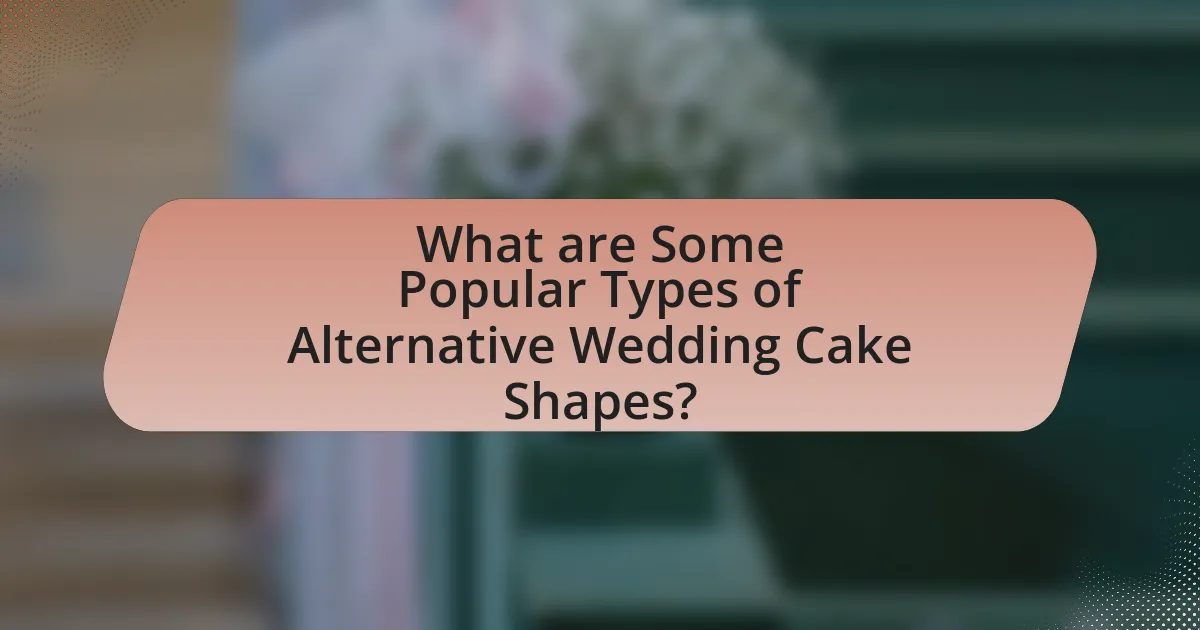
What are Some Popular Types of Alternative Wedding Cake Shapes?
Some popular types of alternative wedding cake shapes include geometric designs, floral shapes, and sculpted cakes. Geometric designs often feature clean lines and modern aesthetics, appealing to couples seeking a contemporary look. Floral shapes can mimic the appearance of blooming flowers, adding a romantic touch to the celebration. Sculpted cakes, which can take on various forms such as animals, objects, or even landscapes, allow for personalized themes and creativity. These shapes reflect current trends in wedding cakes, moving away from traditional tiered styles to more unique and customized options.
What are the characteristics of geometric-shaped wedding cakes?
Geometric-shaped wedding cakes are characterized by their angular designs, clean lines, and often multi-faceted surfaces. These cakes typically feature shapes such as hexagons, triangles, or cubes, which create a modern aesthetic that contrasts with traditional round cakes. The use of bold colors and textures, such as metallic finishes or matte surfaces, enhances their visual appeal. Additionally, geometric cakes may incorporate elements like sharp edges and asymmetrical layers, contributing to a contemporary and artistic presentation. This design trend reflects a growing preference for unique and personalized wedding cake styles that stand out in modern celebrations.
How do hexagonal or octagonal cakes stand out?
Hexagonal and octagonal cakes stand out due to their unique geometric shapes that break away from traditional round designs. These shapes create a visually striking appearance, allowing for more creative decoration and presentation options. For instance, hexagonal cakes can be stacked in a way that enhances their structural integrity while providing a modern aesthetic, which appeals to couples seeking a contemporary look for their wedding. Additionally, the use of these shapes can symbolize harmony and balance, as hexagons and octagons are often associated with nature and design principles. This distinctiveness makes them a popular choice for alternative wedding cakes, catering to those who desire a cake that reflects their personal style and stands out at the celebration.
What design elements enhance geometric cakes?
Geometric cakes are enhanced by design elements such as sharp angles, clean lines, and contrasting colors. These elements create a modern aesthetic that emphasizes the cake’s structure and form. For instance, the use of fondant or ganache can provide a smooth finish that highlights the geometric shapes, while bold color palettes can draw attention to the cake’s unique design. Additionally, incorporating metallic accents or geometric patterns can further elevate the visual appeal, making the cake a striking centerpiece.
What are the features of sculpted wedding cakes?
Sculpted wedding cakes are characterized by their three-dimensional designs that often mimic objects, themes, or characters, making them visually striking and unique. These cakes typically feature intricate detailing, such as fondant or gum paste decorations, which allow for realistic textures and shapes. Additionally, sculpted wedding cakes often incorporate multiple flavors and fillings, catering to diverse tastes while maintaining aesthetic appeal. The use of structural supports is common to ensure stability, especially for larger or more complex designs. These features collectively enhance the cake’s artistic expression and personalization, setting them apart from traditional tiered cakes.
How do sculpted cakes reflect the couple’s interests or hobbies?
Sculpted cakes reflect the couple’s interests or hobbies by incorporating specific designs and themes that resonate with their personal passions. For instance, a couple who enjoys hiking may choose a cake shaped like a mountain, while those who love music might opt for a cake resembling a guitar. These choices not only personalize the wedding experience but also serve as a visual representation of the couple’s shared experiences and values. The customization of sculpted cakes allows for a unique expression of identity, making the cake a memorable centerpiece that aligns with the couple’s lifestyle and interests.
What techniques are used to create intricate sculpted designs?
Intricate sculpted designs are created using techniques such as fondant sculpting, gum paste modeling, and airbrushing. Fondant sculpting involves rolling and shaping a pliable icing to form detailed figures and textures, allowing for smooth finishes and complex designs. Gum paste modeling is utilized for creating delicate and intricate elements, as it dries hard and can be molded into fine details like flowers and lace. Airbrushing adds depth and color gradients to the designs, enhancing the visual appeal and realism of the sculpted elements. These techniques are commonly employed in cake decorating to achieve artistic and visually stunning results.
What are the advantages of using cupcake towers or dessert tables?
Cupcake towers and dessert tables offer several advantages for weddings, including visual appeal, variety, and ease of serving. The visual presentation of a cupcake tower can create a stunning focal point, enhancing the overall decor of the event. Additionally, dessert tables provide a diverse selection of treats, catering to different tastes and dietary preferences, which can be more inclusive than a traditional cake. Furthermore, serving individual portions from a cupcake tower or dessert table simplifies the serving process, reducing the need for cutting and plating, thus streamlining the event flow. These factors contribute to a more enjoyable and memorable experience for guests.
How do these options provide variety for guests?
Alternative wedding cake shapes provide variety for guests by offering diverse visual and flavor experiences that deviate from the traditional tiered cake. These options can include unique shapes such as geometric designs, sculpted figures, or even themed cakes that reflect the couple’s interests, enhancing the overall aesthetic of the celebration. Additionally, alternative shapes often allow for a wider range of flavors and fillings, catering to different tastes and dietary preferences, which can include gluten-free, vegan, or specialty flavors. This variety not only satisfies individual guest preferences but also creates a memorable and personalized experience that stands out from conventional wedding cakes.
What are the logistical benefits of cupcake towers compared to traditional cakes?
Cupcake towers offer several logistical benefits over traditional cakes, primarily in terms of ease of transport, serving, and storage. Unlike traditional cakes, which can be heavy and require careful handling to avoid damage, cupcake towers are lighter and can be easily transported without the risk of collapsing. Additionally, serving cupcakes is more efficient; guests can simply take their own, eliminating the need for slicing and serving, which can slow down the process. Furthermore, cupcake towers can be stored more conveniently, as they often require less refrigeration space and can be kept at room temperature for a longer period without compromising quality. These factors make cupcake towers a practical choice for events where logistics play a crucial role.
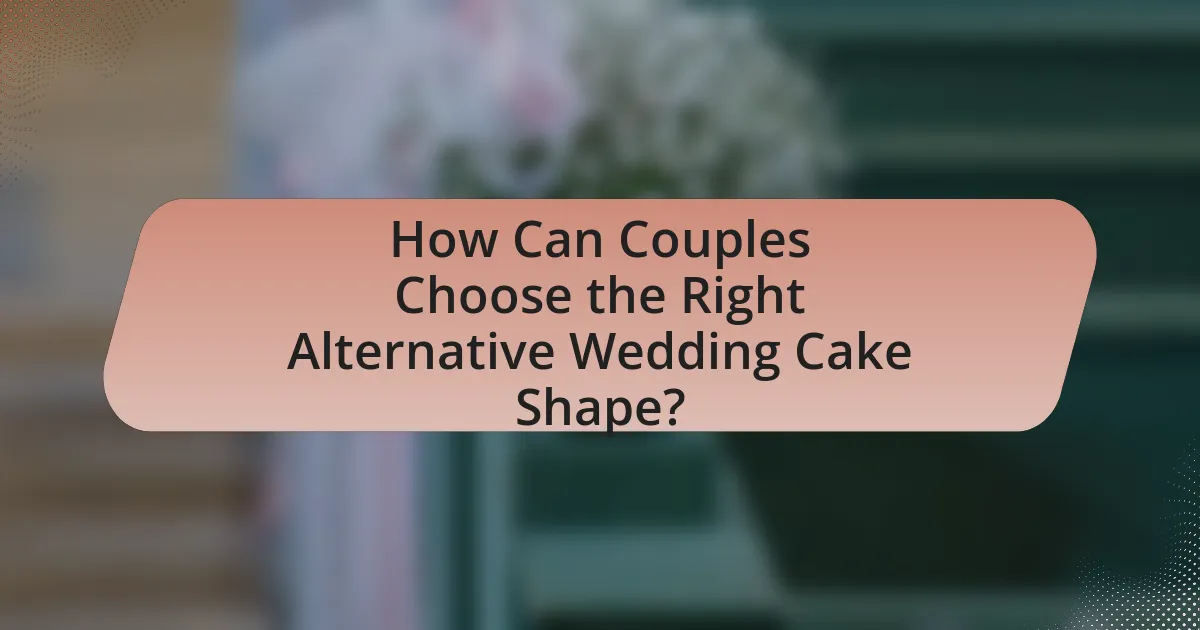
How Can Couples Choose the Right Alternative Wedding Cake Shape?
Couples can choose the right alternative wedding cake shape by considering their wedding theme, personal style, and guest preferences. Selecting a shape that aligns with the overall aesthetic of the wedding, such as geometric designs for a modern theme or floral shapes for a romantic vibe, enhances visual harmony. Additionally, couples should think about practicality; for instance, a square or hexagonal cake can be easier to cut and serve. Research indicates that 70% of couples prioritize personalization in their wedding choices, making it essential to select a shape that reflects their unique relationship.
What tips should couples consider when selecting an alternative cake shape?
Couples should consider their wedding theme and personal style when selecting an alternative cake shape. A cake that aligns with the overall aesthetic of the wedding enhances the visual appeal and creates a cohesive atmosphere. For instance, geometric shapes can complement a modern wedding, while floral or nature-inspired designs may suit a rustic theme. Additionally, couples should think about the practicality of the shape, including serving size and ease of cutting. Cakes shaped like hearts or initials can add a personal touch, reflecting the couple’s identity. Ultimately, the chosen shape should resonate with the couple’s preferences and the event’s ambiance, ensuring a memorable experience for both the couple and their guests.
How can they ensure the cake aligns with their wedding theme?
To ensure the cake aligns with their wedding theme, couples should select colors, designs, and flavors that reflect the overall aesthetic and mood of the wedding. For instance, if the wedding theme is rustic, a cake with natural elements like floral decorations and earthy tones would be appropriate. Additionally, incorporating thematic elements such as specific shapes or motifs that resonate with the wedding’s style can enhance cohesion. Research indicates that visual consistency in wedding elements, including the cake, significantly contributes to the overall guest experience and satisfaction, reinforcing the importance of alignment with the wedding theme.
What should they discuss with their baker regarding design and feasibility?
They should discuss the specific design elements they envision for the wedding cake, including shape, size, and any unique features such as color schemes or decorations. This conversation is crucial to assess the feasibility of the design based on the baker’s capabilities, available materials, and baking techniques. For instance, if they desire a non-traditional shape like a hexagon or a sculpted design, the baker can provide insights on structural support and stability, ensuring the cake can be both visually appealing and practical for serving.
What are common mistakes to avoid when choosing alternative wedding cake shapes?
Common mistakes to avoid when choosing alternative wedding cake shapes include neglecting the cake’s structural integrity, overlooking the theme and style of the wedding, and failing to consider serving sizes. Structural integrity is crucial; unconventional shapes may require additional support to prevent collapsing, which can lead to a disastrous presentation. Additionally, the chosen shape should align with the overall wedding theme to ensure visual harmony; for instance, a geometric cake may clash with a rustic wedding. Lastly, it is essential to calculate the number of guests accurately, as some shapes may yield fewer servings than expected, potentially leaving guests without cake.
How can couples prevent miscommunication with their cake designer?
Couples can prevent miscommunication with their cake designer by clearly articulating their vision and preferences during initial consultations. This includes providing specific examples of desired cake shapes, flavors, and designs, which can be supported by visual references such as photos or sketches. Additionally, couples should establish a detailed contract that outlines all agreed-upon specifications, deadlines, and payment terms to minimize misunderstandings. Regular follow-up communication throughout the design process ensures that any changes or concerns are addressed promptly, fostering a collaborative relationship.
What should they consider about guest preferences and dietary restrictions?
When planning an alternative wedding cake, hosts should consider guest preferences and dietary restrictions to ensure inclusivity and satisfaction. This includes identifying common dietary needs such as gluten-free, vegan, nut-free, and dairy-free options, as approximately 30% of the population has some form of dietary restriction. Additionally, understanding guests’ flavor preferences can enhance the overall experience, as surveys indicate that 70% of guests appreciate personalized cake flavors that reflect their tastes. By accommodating these factors, hosts can create a memorable and enjoyable dessert experience for all attendees.
